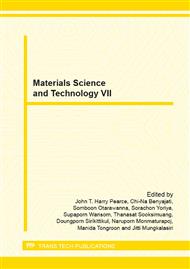p.182
p.188
p.193
p.197
p.211
p.219
p.225
p.230
p.236
Effect of Helium Addition in Argon Shielding Gas on Metal Transfer Behavior in Gas Metal Arc Welding of Aluminum
Abstract:
Helium is widely used as mixing with argon for a shielding gas in GMAW process of Aluminum in order to improve weld quality and increase heat transfer to the weld pool. It has been known that helium could affect metal transfer behavior; however, its behavior has not been well understood. In this study, an analysis of the metal transfer behavior in the GMAW of aluminum was studied. The main objective is to study the effect of Helium on metal transfer in two main regions, short circuit (low welding current region) and spray transfer (high current region). The composition of 5 types of shielding gases were pure argon, 75%Ar + 25%He, 50%Ar + 50%He, 25%Ar + 75%He and pure helium. The welding parameters were fixed at 90A/17.0V, 100A/18.2V, 140A/24.6V and 180A/27.6V. Aluminum plates were welded bead-on-plate in a flat position. The metal transfer behavior was analyzed by using acoustic signals and arc voltage signals. For the result, at low welding current of 90A and 100A with pure argon, short-circuit transfer mode was observed. Adding helium in gas mixture gave no effect in metal transfer mode in low welding current regions but the metal transfer rate was slightly increased. At high welding currents of 140A and 180A with pure argon, spray transfer mode was observed and when increasing helium in gas mixture resulted in changing from spray transfer to combined mode of spray-globular. In these high welding currents, adding helium in gas mixture resulted in decreasing the metal transfer rate since helium gas tended to promote globular metal transfer. Acoustic signal and arc voltage signal can be used effectively in determining modes of metal transfer.
Info:
Periodical:
Pages:
219-224
Citation:
Online since:
March 2013
Authors:
Keywords:
Price:
Сopyright:
© 2013 Trans Tech Publications Ltd. All Rights Reserved
Share:
Citation:


